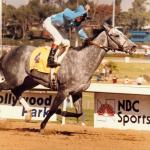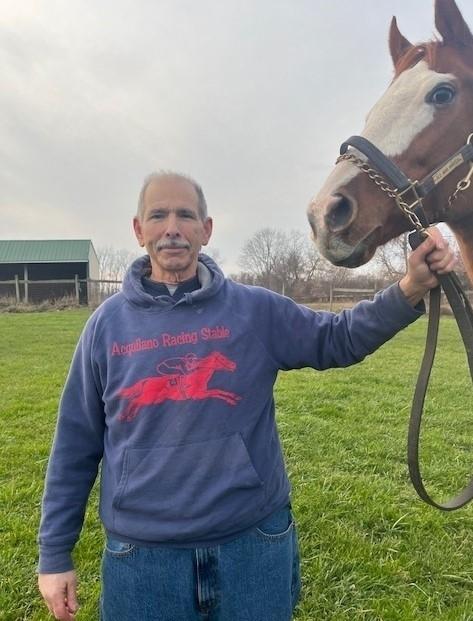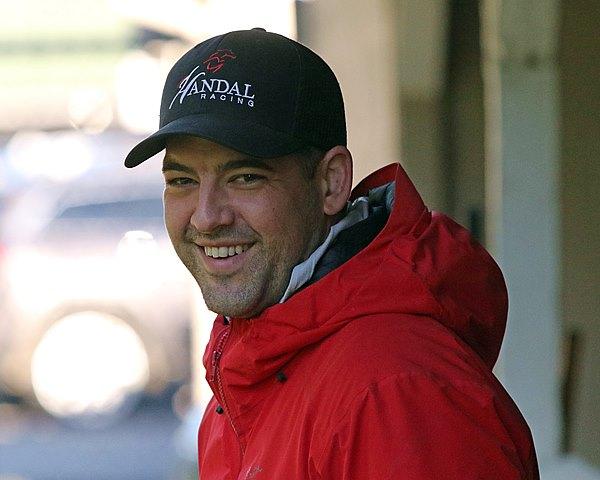
Golden Tempo Goes Last-to-First to Capture Lecomte Stakes at Fair Grounds

BloodHorse story by Tim Sullivan
Ray Handal is looking for longevity. He trains his horses with a level of caution not always conducive to keeping clients, but one that has earned him a rare distinction.
Now in his 10th year as a trainer, after more than 1,500 starts and more than $13 million in earnings, Handal has yet to have a horse die in his care. Not from racing. Not in training. Not from illness. Not by accident. Not from natural causes.
Not one, he says, a claim substantiated by his fatality-free record in the New York State Gaming Commission’s Equine Breakdown, Death, Injury and Incident Database.
“If everybody trained like me,” Handal said, “I promise you we’d have half the breakdowns that we have.”
With efforts to improve equine safety so prominent in racing’s plans and so central to the sport’s public perception, those trainers who have excelled at avoiding catastrophic injuries are worth studying, and, perhaps, copying. BloodHorse researched trainer records from 2020-2022 in California and New York — two of the rare states that track catastrophic breakdowns by trainer during racing or training and make those figures public. BloodHorse found that of the 83 trainers with at least 400 starts in one of those states during that three-year span, 19 did not have a single breakdown (in the state examined).
Handal’s methods have trounced those average mortality rates.
“It’s something I pride myself on,” he said. “I actually talk about this with my vets all the time. We do a lot of lameness exams—before it was even mandatory or any of these new rules were implemented. Far before [the Horseracing Integrity and Safety Authority], before every horse in my barn had a workout, I’d watch the horse jog.
“If they’re lame, I usually do diagnostics and X-rays right away. If there’s a problem, I send them away and do a lot of surgeries for minor stuff. I don’t like to push the envelope and I’ve had horses have really long careers because of it. If you get on them right when problems start to surface, you’ll have a horse that lasts a lot longer.”
According to The Jockey Club’s Equine Injury Database, Thoroughbred racing’s incidence of fatal breakdowns during racing has declined four years in a row and last year reached its lowest rate since the initiative was launched in 2009 (1.25 fatal injuries per 1,000 starts). New York and California also track equine fatalities in the mornings.
From 2020-22, New York tracks lost 97 Thoroughbreds to racing injuries and another 119 in training, according to state records. During that span, Thoroughbreds made 53,619 starts in 7,118 races in the state. Applying a “per start” number to breakdowns in racing and training, the average in New York at this time was 3.97 per 1,000 starts (or one every 248.2 starts).
During that same span, California Horse Racing Board data shows 56 Thoroughbreds died in racing and 74 in training. With 62,843 starts from 8,929 races in the Golden State from 2020-22, that’s a rate of 2.07 per 1,000 starts if we apply the “per start” standard for breakdowns in racing and training.
However, some trainers fare much better than those state averages.
California trainer Tim McCanna, who had zero fatalities racing or training in 859 starts from 2020-22, credits a strategic shift toward younger horses and giving those horses time to recover from any issues that occur. He also believes the forgiving all-weather surface of his home track, Golden Gate Fields, plays in his favor. In endorsing all-weather tracks, McCanna says, “The numbers don’t lie. I’m surprised nationally they haven’t gone to it.”
“I’ve been training 40-some years,” he said. “When I first started training with my dad, all we had were old horses who’d been hurt. When I was a senior in high school, our youngest horse was 8 years old. They were all just old warriors. ...
“After a few years, I decided I wanted to get them before they were hurt. I started buying 2-year-olds and yearlings … I got to the point where as soon as they had a little something go wrong, I’d try to get them off the track, because one thing led to another. When something starts to go, it leads to something else usually.”
Warning signs include a subtle change in a horse’s gait, a loss of appetite, or a discouraging word from a jockey or exercise rider atop the saddle.
“I rely on my exercise riders a lot,” McCanna said. “They’re on them and all of a sudden they say, ‘Something’s not the same here. He’s not feeling the way he’s felt.’ We’ll get together with the vet and try to determine what it is. A lot of times you’ll turn them out without ever determining what exactly it was. When a horse is off, the best thing is to turn them out until they’re good.”
Because taking a horse out of training can mean months of not racing, the costs of rehabilitation come into play. Though trainers invariably insist they put the welfare of the horse first, the pressure to pay bills and placate owners can create a conflicting interest. McCanna said that second interest cannot win out.
“You’ve got to kind of forget about that,” McCanna said. “If I thought about how much I’ve got into them, it would drive me crazy. I know what it costs and it’s not easy. But where our sport’s at now, you just can’t take any chances. Not that you could before. But we’ve got to get those numbers as low as we can get them.”
Jim Acquilano, a training fixture at Finger Lakes Gaming & Race Track, saw no catastrophic breakdowns by his horses in training or racing from 2020-22 in New York, a stretch in which he had 481 starts. While Acquilano does his best to protect his horses, he also knows that not everything can be controlled.
“You can’t get rid of catastrophic injuries completely,” Acquilano said. “You’ve got 1,000-pound animals going 25-30 miles an hour. Things are going to happen ...
“Earlier in the season, I had the reins break on a horse and the horse came over and almost knocked over the inside rail. The horse almost fell down. I thought she broke down, to tell you the truth, the way her action stopped. But it was a couple of scrapes and nothing. Was I a great trainer or did I have a secret or was I lucky?”
Now in his fifth decade of training, after more than 10,000 starts and nearly 2,000 victories, Acquilano has not lost a horse since May 27, 2017, when a 3-year-old gelding named On the Deadline broke down in his first race after being claimed. But the trainer rejects the notion that his impressive safety record is the product of some special insight.

“There’s no secret,” he said. “Everybody’s paying attention. I don’t know what to tell you. I don’t want to just make it more than what it is, like I’m some kind of genius or something. My wife can tell you I’m no genius.”
Still, an analysis of available records suggests certain practices are conducive to keeping horses healthy and certain practitioners are far less susceptible to breakdowns than are some others. As the sport aims to improve equine safety, trainers in this category could become an important asset.
Near the end of the 2023 meet at Saratoga Race Course, Handal detected a comparatively minor problem with a promising unraced 2-year-old filly named La Salvadorena. A knee warm to the touch prompted the trainer to order an X-ray, which revealed “the beginnings of a very small chip in the upper joint.”
“There was no risk of it being a catastrophic breakdown,” Handal said. “But it was detrimental to the horse’s future because the area it was in was right up close to the joint.”
Owner Jay Alonzo and three partners had paid $90,000 for the filly — “the most expensive horse I ever bought,” Alonzo said. The costs associated with surgery and a long layoff were significant for the small-time partnership.
“Ray’s bills ain’t cheap; I’m sure nobody’s are,” said Alonzo, who figures La Salvadorena’s healing process costs his group $5,000 per month. “But it’s like anything else: You buy a nice car. You want to take your girl out on a date. But something might be wrong, so you probably don’t take that car ...
“As an owner, I want to run every day. Ray’s patient. There’s always next month if something’s wrong. That does [upset owners] because we want to run. We want the checks. That’s short-termism. But you’ve got to do the right thing for the horse. Short-termism never works. Long-termism always pays off.”
With Thoroughbred tracks now subject to uniform reporting requirements for the first time under the Horseracing Integrity and Safety Authority, HISA’s hope is that sophisticated data analysis will shed light on such matters as medication, training methodology, and claiming patterns that will lead, in turn, to fewer equine injuries.
A partnership with Palantir Technologies announced Dec. 5 will provide a daily report for each racetrack, “flagging any horses entered in that day’s races who may present potential risk factors for injury.”
Pre-race inspections, presumably, will henceforth get more granular.
“Making informed decisions that allow you to put the health of the horse first is precisely the goal of the work that we’re doing to create a comprehensive analytics and insights platform,” HISA CEO Lisa Lazarus said. “This platform will use our data to test experts’ hypotheses about the root causes of equine injuries and provide horses’ care teams with the tools needed to help prevent injuries. . .
“We believe that preventive care is the right thing to do from an equine welfare point of view. But we also expect it to result in extending a horse’s career and reducing the costs associated with caring for an injured horse.”
HISA has looked at addressing trainers with a high number of equine deaths, although it can be challenging.
“We are looking at it, but it’s complex, right?” Lazarus told BloodHorse in October, noting that perhaps a catastrophic breakdown for a trainer is caused by an unsafe surface or by interference from another horse — situations Acquilano also referenced.
Lazarus noted that HISA does use equine fatality numbers for trainers in its investigations. That is to say, a poor safety record may warrant scrutiny.

On the other end, more can be learned from the trainers who are doing better than average in the equine safety category. BloodHorse research suggests that, as a group, the 19 trainers referenced earlier with no breakdowns in either New York or California are less reliant on medication during training. Of those 19 trainers, 16 did not have a violation for what HISA refers to as controlled medications during the three years examined at OwnerView.com. In fact, 14 of the 19 trainers had no such violations, or only one such violation, in the past 10 years.
Such an approach typically goes hand in hand with giving horses time off to recover from ailments. Handal believes owners could help trainers by making it clear that they’re willing to give a horse this time when it’s needed. He believes that would reduce pressure on conditioners.
Handal calls for improved communication between trainers and owners. He believes many owners are misled about the health of their horses, possibly by trainers afraid to lose clients. Though he recognizes candor and caution have likely cost him some business, “I like to do it my way because I think my way is the best.”
His advice for owners?
“Just don’t leave questions on the table when it comes to soundness of horses. Investigate. Do your due diligence. If everybody did what I did, I think everybody would be in better shape.”